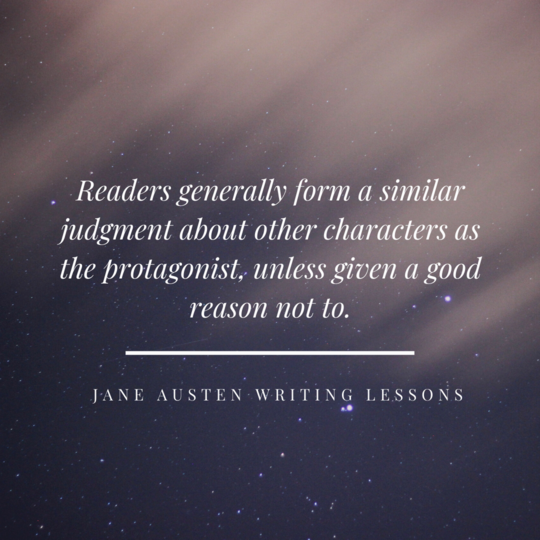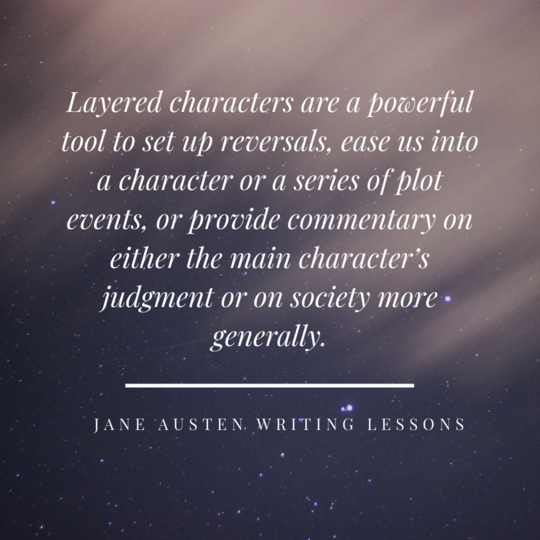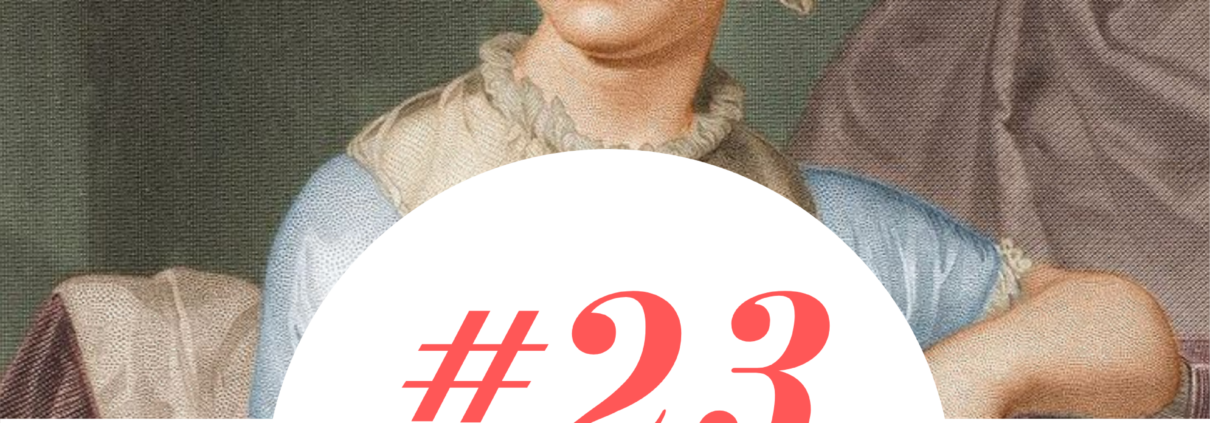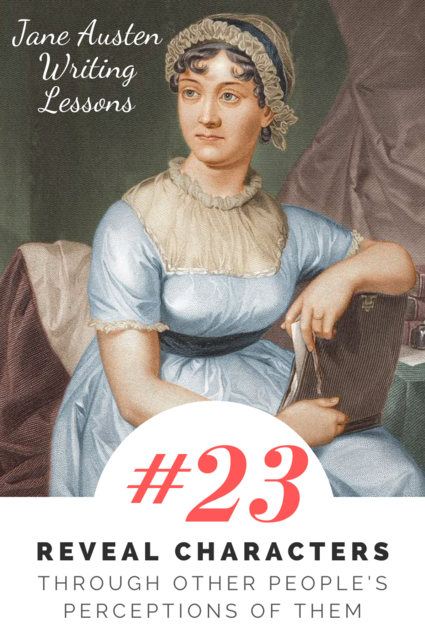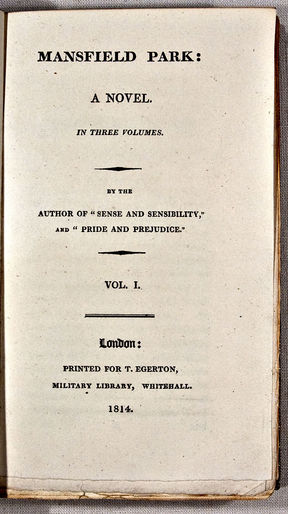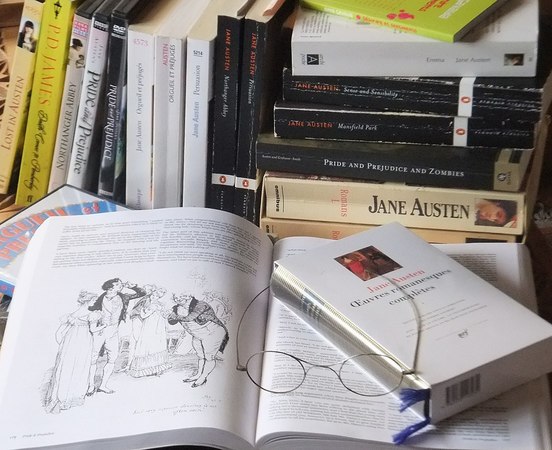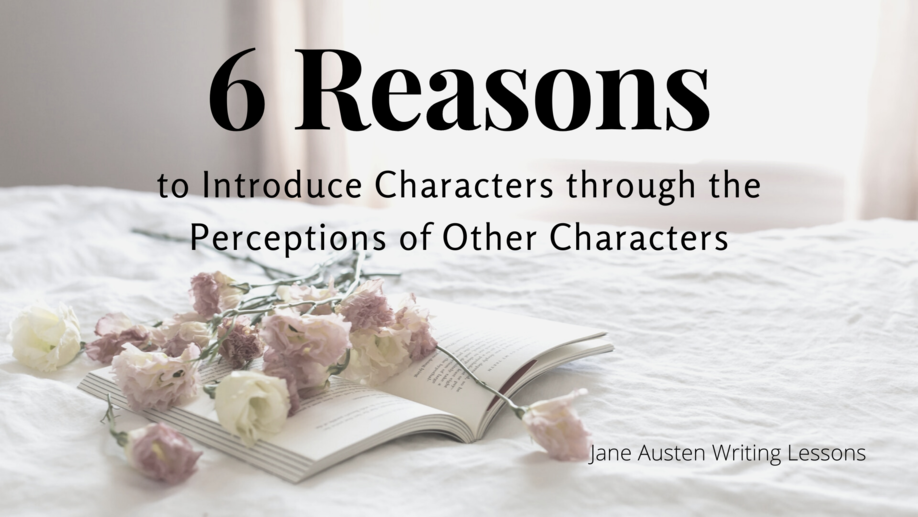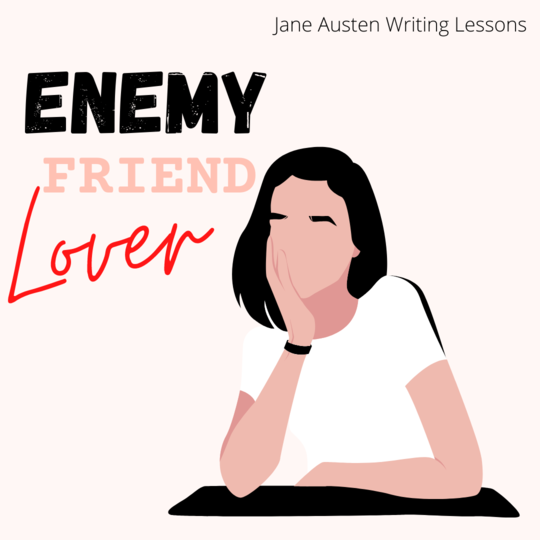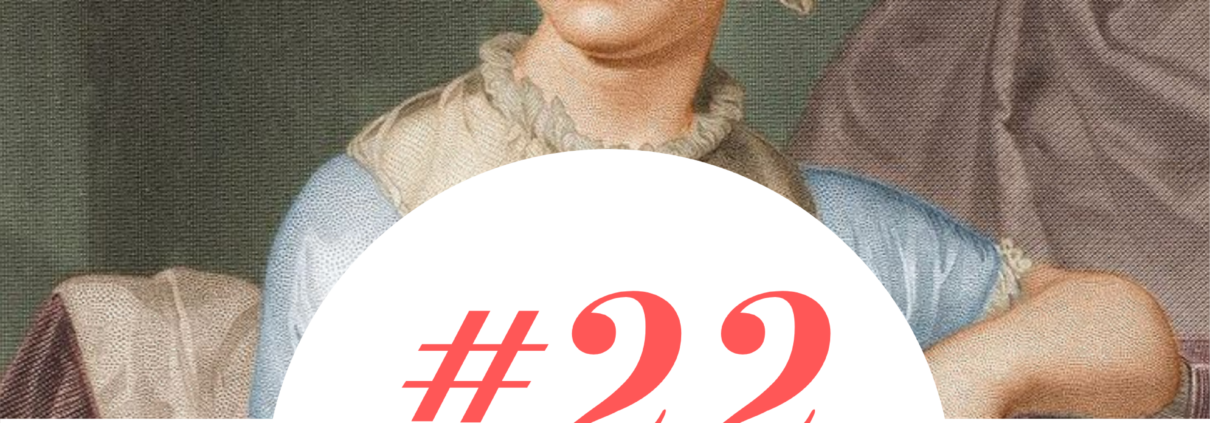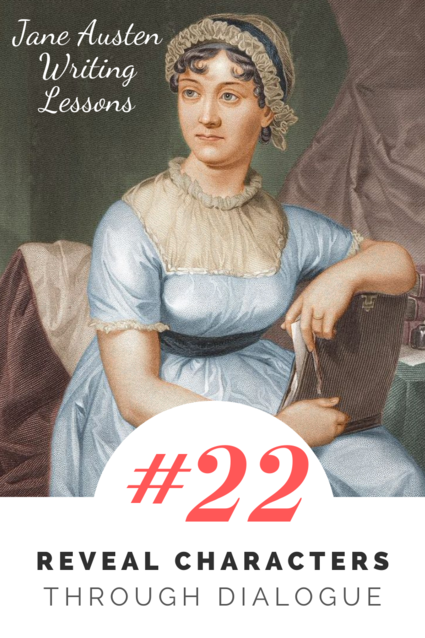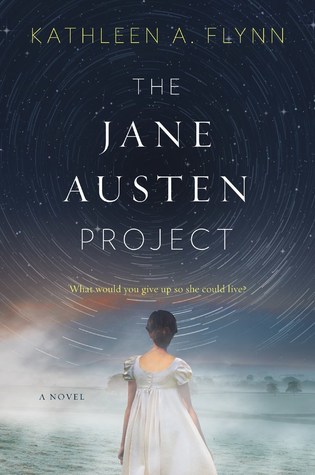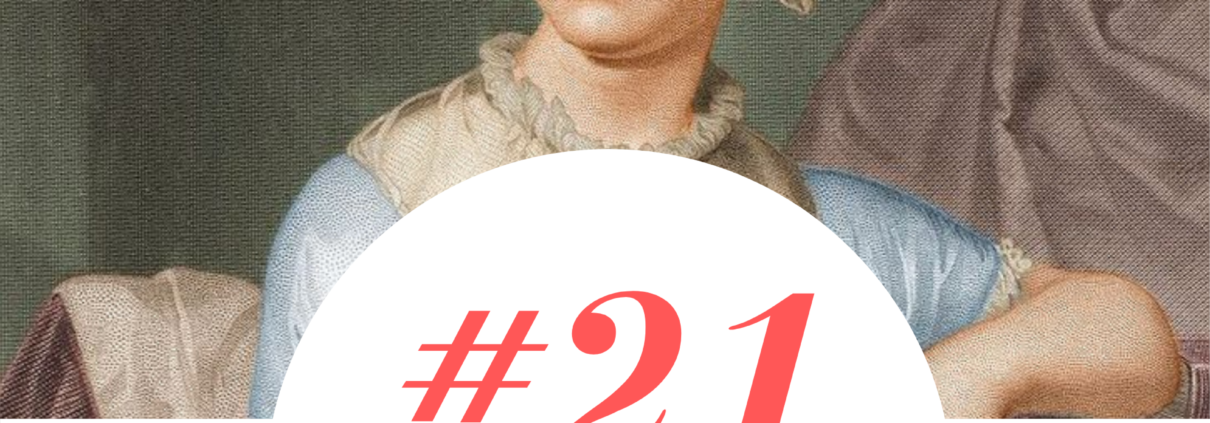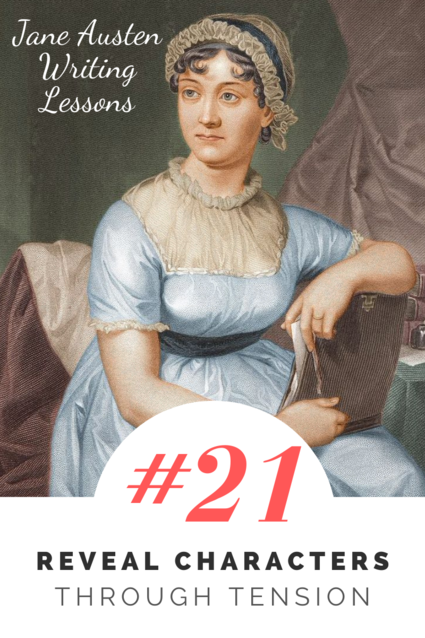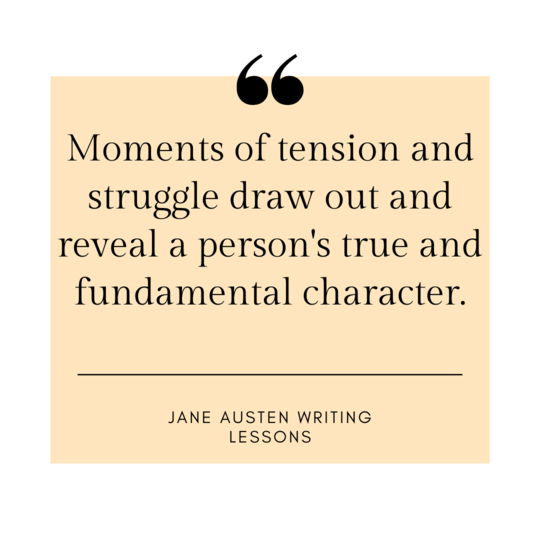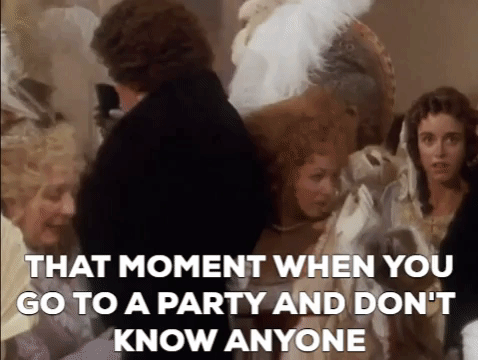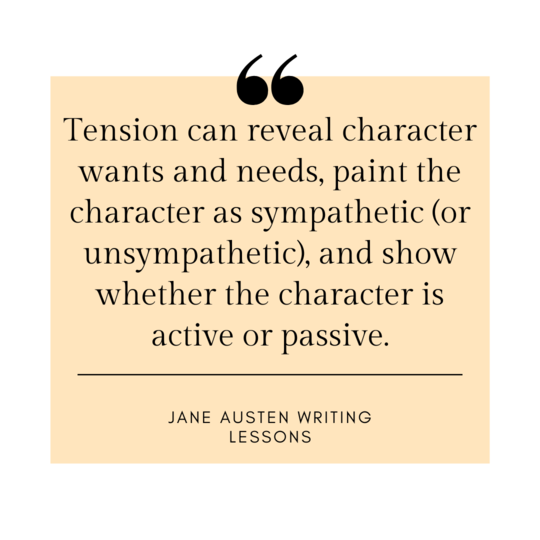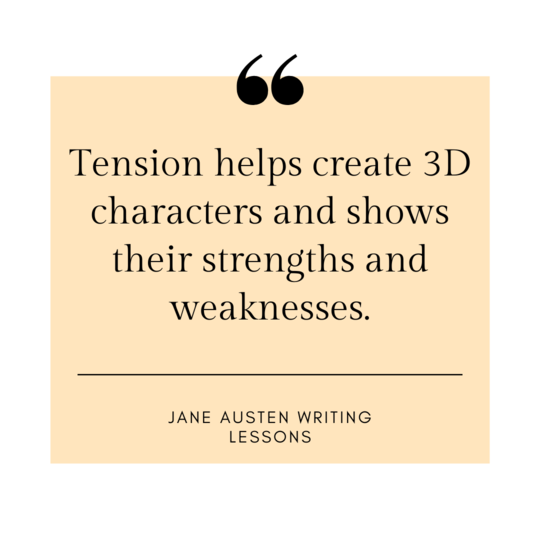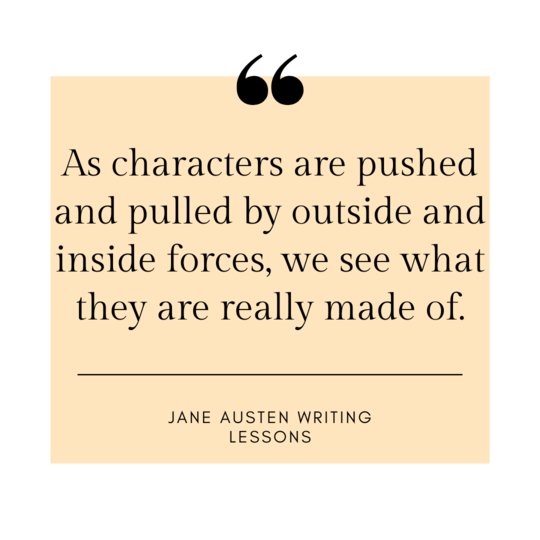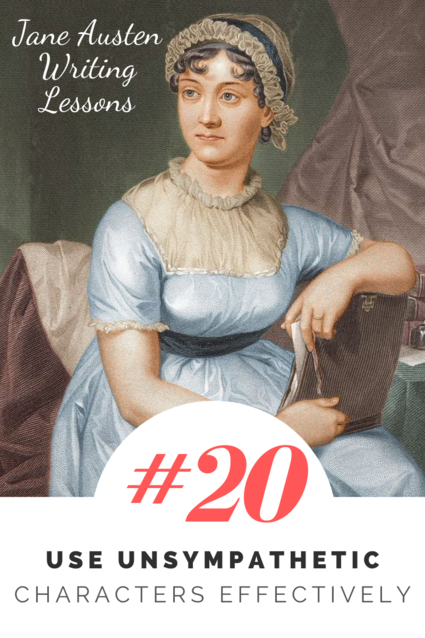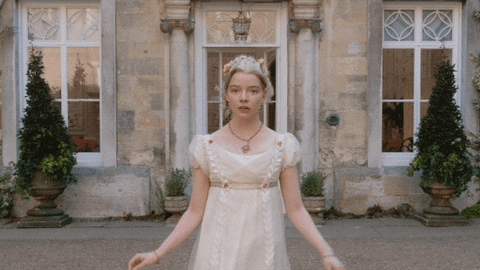#25: Use Antagonists and Villains to Interfere
A number of books and blog posts on writing talk about creating a single main antagonist or villain, who actively works in opposition to the main character over the course of the story.
Yet this isn’t how Jane Austen uses antagonists and villains in her novels. Many of her books don’t have a primary antagonist. And only a few of her books have villains—there’s even some debate over whether any of her characters qualify as villains at all.
Over the coming weeks, we’re going to explore how Jane Austen uses obstacles, antagonists, and villains with great effect. Some of my personal favorites in terms of Austen characters fall into these categories—Lady Catherine de Bourgh, Willoughby, Jane Fairfax, and even Mr. Knightley (yes, he definitely acts as an antagonist!).
This week we’re going to define some of the key terms related to obstacles, antagonists, and villains in a way that helps us understand how Jane Austen uses them and how we can use them in our own writing. Examples will come from Austen’s novel Mansfield Park.
Obstacles
Obstacle=something which gets in the way of the character as they go on their journey. This may be a challenge, a physical or emotional impediment, or anything which must be overcome in order for the characters wants and needs to be met.
I talked about obstacles in two previous posts. In Make Things Hard for Your Character I discussed three types of challenges: external obstacles, successes/triumphs, and internal flaws/challenges. The post on creating character arcs also discusses obstacles, albeit a little more indirectly.
In Mansfield Park, an example of an obstacle is when Fanny Price’s horse dies. Suddenly she has no way to exercise, which has a huge negative impact on her health, and perhaps more seriously, she loses the small amount of autonomy, independence, and freedom she had because of her horse.
Obstacles can be inactive or active.
Inactive Obstacle: a present and existing obstacle which is a challenge for the character, but does not have active force applied to create this challenge.
One of Fanny’s sources of inactive opposition is her poverty. Her poverty makes her beholden to her uncle and aunts, and it robs her of power and decision-making. This poverty is not something that has changed over time, and there seems to be no way that it could change. No one is actively making her poor, no single event has created this poverty—it’s just the way it is.
Active Obstacle: an obstacle which includes the active application of negative force on a character. This can be a one-time obstacle, an obstacle that happens multiple times, or an obstacle that happens continuously.
One example of the active obstacle is the choice of her cousins and their friends to perform what to her is a rather objectionable play. Then they try to force her to act in it against her wishes.
Another active obstacle, which is more continuous, is Henry Crawford’s proposal. Crawford devotes huge amounts of time attempting to manipulate Fanny, and Fanny’s uncle, Lord Bertram, also convinces her to accept the proposal and punishes her when she does not.
Antagonism
Antagonism=active opposition to a character, often with hostility.
According to the New Oxford American Dictionary, in the field of biochemistry, antagonism “inhibition or interference with the action of one substance or organism by another.” To me this is really useful for stories, particularly the sense of “inhibition or interference” of someone’s actions.
Whenever one character opposes another character, whenever a character inhibits or interferes with another characters actions, they are showing antagonism.
Antagonism with hostility – Much antagonism is accompanied by hostility, which includes negative emotion, often unfriendliness.
An example of characters that show antagonism with hostility are Lord and Lady Bertram. They feeling that Fanny should be treated as lesser and separate than their children, and that she should be reminded of all she has been given that she does not deserve. This results in many things, including her sleeping in a cold room in the attic (with no fire in the winter!), apart from the rest of the family.
Antagonism without hostility – some antagonism or active opposition occurs without any hostility or ill-will.
Edmund, Fanny’s cousin, is her closest friend and confidante. And yet he does things which inhibit and oppose Fanny, though with no ill will. When the horse she uses dies, he gets her a new horse to use, but then he lends it out constantly to his love interest, which inhibits Fanny. Edmund also tries to get Fanny to marry Henry Crawford, and does not listen to her perspective or her reasoning for not wanting to marry Crawford.
Antagonism vs. Antagonist
I’ve included antagonism as a separate category than an antagonist, because while all antagonists manifest antagonism, not all characters who manifest antagonism at some point in a story are true antagonists.
Personally, I would categorize Lord Bertram as an antagonist, because he truly is actively opposing Fanny on a regular basis, while I would categorize Lady Bertram and Edmund simply as characters sometimes behaving with antagonism to the main character.
Antagonist
Antagonist – a person who actively opposes the main character and tries to interfere with them achieving their wants and needs, typically over multiple scenes or a large portion of the story.
An example of this is Mrs. Norris.

I’m not talking about the cat in Harry Potter (though I’ve heard that the Mansfield Park character is the namesake for the Harry Potter antagonist, which makes me very happy). I’m talking about Fanny’s aunt.
Despite all their years in close proximity, Mrs. Norris never gives Fanny any love. She is constantly belittling, disregarding, and mistreating Fanny. She attempts to put Fanny in her place, and at times even threatens her at times. Not only does she make Fanny’s life miserable, she also influences others to mistreat Fanny.
Villain
Villain – an antagonist who causes significant, lasting, and often irreversible harm in the main character’s life or in the lives of those the main character cares deeply about.
Henry Crawford decides to make Fanny love him as a sort of game, simply because she’s the only unwed female who isn’t interested in him. Thus begins his manipulations, and his antagonism/interference in Fanny’s life.
Ultimately [SPOILERS IN THIS SENTENCE!] he ends up seducing Fanny’s cousin Maria Bertram, and not long after Maria’s marriage they elope together. This brings shame to the whole family, and, because it’s the Regency, “ruins” Maria.
(Some readers classify Henry Crawford as an antagonist but not a villain. Other people find him to be the most interesting character, and some authors have even written fanfiction in which he does end up with Fanny and they’re both happy as a result. He does fit well into the “loveable bad boy” archetype.)
In Conclusion
There’s a lot of reasons to use obstacles, antagonism, antagonists, and villains, some of which I talked about in the post on making things hard for your character. There are three key reasons that I’d like to highlight today.
Reasons to use obstacles, antagonism, antagonists, and villains:
- To apply pressure to your character. Only with pressure and challenge can a character change, grow, and prove themselves.
- Story is conflict, and one of the most powerful forms of conflict comes through these sorts of opposition. Antagonists and villains in particular actively interfere with the character’s internal and external journeys.
- It creates verisimilitude to life. All people are on paths, striving, and often our paths interfere with each other.
Next week we’ll go in depth on motives for antagonism. In the coming weeks, we’ll also talk about shifting, temporary, and minor antagonists; unusual antagonists; giving antagonists redeeming characteristics; and specific impacts that antagonists have on both plot and character.
Exercise 1: Make a list of your favorite antagonists and villains from books, movies, or any other stories. Which ones or antagonists? Which ones are villains? Why do you like them?
Exercise 2: Hobby Trouble
Choose a character name and give your new character a hobby—knitting or fencing, stamp collecting or competitive cheesemaking, or anything else. Now write a scene in which antagonism is shown towards the main character and their hobby. This should be opposition, large or small, to the hobby or some aspect of it, or it could be something that inhibits or interferes with the hobby. First the character should receive this sort of interference from some sort of enemy or adverstary, someone who has hostile or unfriendly intent. Then the character should receive some sort of antagonism or interference from a friend or a loved one. As you write this scene, consider how your character will react differently depending on who is providing the antagonism.
Exercise 3: From Antagonist to Villain
Take a story you have written and choose one of your antagonists. Brainstorm what you could do to shift this character from an antagonist to a villain (using the definitions of antagonist and villain provided in this post).
As an alternative, do the reverse and choose a villain you have written. Brainstorm what you could do to shift this character from a villain to an antagonist.
#24: Introduce Layered Characters to Create Deeper or Changed Meaning Later
In Pride and Prejudice, in the letter Mr. Darcy writes to Elizabeth after she rejects his proposal, he explains why he worked to prevent a relationship between his friend, Mr. Bingley, and Elizabeth’s sister, Jane. While it was clear to him that Bingley liked Jane, it was not clear to him that Jane liked Bingley:
“Your sister I also watched. Her look and manners were open, cheerful, and engaging as ever, but without any symptom of peculiar regard, and I remained convinced from the evening’s scrutiny, that though she received his attentions with pleasure, she did not invite them by any participation of sentiment.”
While Darcy interprets Jane’s behavior as reticence and lack of affection, Elizabeth knows Jane more deeply, and recognizes that it reflects a natural shyness and modesty. Ultimately, Darcy does come to agree with Elizabeth’s reading of Jane.
Just as Darcy’s reading of Jane’s character shifts, our reading of characters can also shift over the course of a story.
The last few weeks of Jane Austen Writing Lessons have focused on introducing characters: through tension, through dialogue, and through other characters’ perceptions. This week will address another aspect of introducing characters: sometimes you need to introduce a character who has a particular meaning for the reader originally, and then, as the story progresses, the reader’s understanding of the character deepens or changes. Yet upon a second reading, the original introduction of the character does reveal this second, truer understanding of the character.
It is common for characters to not reveal their full selves to each other—or to readers—when they are first introduced.
We are never our whole selves.
Real people, and well-developed characters, are multifaceted and have many aspects, some of which are contradictory. In any circumstance, it is impossible to be or display all aspects of ourselves—yet at the same time, all aspects influence a character, and in some ways still guide a character’s behavior, even if the aspect is not visible.
Characters often hold parts of themselves back in various situations. Characters also manifest the aspects of themselves that seem to be most relevant to a situation, or that feel most relevant personally and emotionally. In a sense, a character is always positioning themselves. According to Oxford Languages, positioning is “[arranging] in a particular place or way,” or a character portraying themselves “as a particular type of person.”
A character’s positioning can be conscious or unconscious.
In the case of Jane Bennet, she is a very genuine, kind character, and her masking of aspects of herself in unconscious and not meant to cause harm.
In other cases, a character consciously positions themselves in a certain way to achieve certain goals. A great example of this is George Wickham, who attempts to portray himself as a moral person who has been wronged by the terrible Mr. Darcy (though the reverse is actually true—Wickham’s morals are at fault, and he has wronged Mr. Darcy).
How Jane Austen Creates Layered Characters
Jane Austen often creates layered characters, which have both a surface layer or interpretation and interior layers which we will better recognize upon reflection or a second reading.
Surface Layer: outside, observable qualities. The obvious interpretation of character based on the available information.
Interior Layers: the character’s interior motivations, attributes that may not be readily apparent, and qualities we may not recognize or appreciate until we come to know the character better.
Mr. Wickham is an excellent example of this. In the novel, we are introduced to him through two scenes. In the first, Elizabeth and her sisters meet him while visiting Meryton:
All were struck with the stranger’s air, all wondered who he could be….Mr. Denny addressed them directly, and entreated permission to introduce his friend, Mr. Wickham…and he was happy to say had accepted a commission in their corps. This was exactly as it should be; for the young man wanted only regimentals to make him completely charming. His appearance was greatly in his favour; he had all the best part of beauty, a fine countenance, a good figure, and very pleasing address.
Instantly, Elizabeth recognizes a large number of Mr. Wickham’s positive traits—which are all part of the surface of his character.
Shortly after they meet Wickham, Mr. Bingley and Mr. Darcy arrive:
[Mr. Darcy’s eyes] were suddenly arrested by the sight of the stranger, and Elizabeth happening to see the countenance of both as they looked at each other, was all astonishment at the effect of the meeting. Both changed colour, one looked white, the other red. Mr. Wickham, after a few moments, touched his hat—a salutation which Mr. Darcy just deigned to return. What could be the meaning of it?—It was impossible to imagine; it was impossible not to long to know.
Our introduction to Wickham continues in the next chapter, when Elizabeth manages a private conversation with Wickham:
[Elizabeth] was very willing to hear [Mr. Wickham], though what she chiefly wished to hear she could not hope to be told, the history of his acquaintance with Mr. Darcy. She dared not even mention that gentleman. Her curiosity however was unexpectedly relieved. Mr. Wickham began the subject himself. He inquired how far Netherfield was from Meryton; and, after receiving her answer, asked in an hesitating manner how long Mr. Darcy had been staying there.
“About a month,” said Elizabeth; and then, unwilling to let the subject drop, added, “he is a man of very large property in Derbyshire, I understand.”
“Yes,” replied Wickahm;–“his estate there is a noble one. A clear ten thousand per annum. You could not have met with a person more capable of giving you certain information on that head than myself—for I have been connected with his family in a particular manner from my infancy.”
Elizabeth could not but look surprised.
“You may well be surprised, Miss Bennet, at such an assertion, after seeing, as you probably might, the very cold manner of our meeting yesterday.—Are you much acquainted with Mr. Darcy?”
“As much as I ever wish to be,” cried Elizabeth warmly,–I have spent four days in the same house with him, and I think him very disagreeable.”
“I have no right to give my opinion,” said Wickham, “as to his being agreeable or otherwise. I am not qualified to form one. I have known him too long and too well to be a fair judge. It is impossible for me to be partial….”
On the surface, Wickham is very agreeable. Elizabeth much prefers his attentions to those of Mr. Collins (unlike Mr. Collins, Wickham is handsome and interesting to talk to). She already does not like Mr. Darcy, and so she is inclined to trust anyone who has come to a similar conclusion.
As readers, we are inclined to feel the same way about Wickham as Elizabeth feels: readers generally form a similar judgment about other characters as the protagonist, unless given a good reason not to.
As the scene continues, Wickham praises Mr. Darcy’s father. The topic then switches to other, more general subjects, but then Wickham brings the conversation back to his misfortunes. His story draws on the heartstrings, and Elizabeth feels for him as he describes how Mr. Darcy prevented him from having his intended career.
“There was just such an informality in the terms of the bequest as to give me no hope from law. A man of honour could not have doubted the intention, but Mr. Darcy chose to doubt it—or to treat it as a merely conditional recommendation, and to assert that I had forfeited all claim to it by extravagance, imprudence, in short any thing or nothing. Certain it is, that the living became vacant two years ago, exactly as I was of the age to hold it, and that it was given to another man….”
“That is quite shocking!—He deserves to be publicly disgraced.”
“Some time or other he will be—but it shall not be by me. Till I can forget his father, I can never defy or expose him.”
Elizabeth honoured him for such feelings, and thought him handsomer than ever as he expressed them.
“But what,” said she after a pause, “can have been his motive?—what can have induced him to behave so cruelly?”
“A thorough, determined dislike of me—a dislike which I cannot but attribute in some measure to jealousy. Had the late Mr. Darcy liked me less, his son might have borne with me better.”
The surface layer continues to paint Wickham in a positive light, yet throughout the entire scene, there are interior layers that we will recognize later. Here are two examples:
- From the start, Elizabeth knows that she can’t ask Wickham about what happened between him and Darcy. In good society, this is an unacceptable topic to bring up with a new acquaintance. Elizabeth is very happy that he brings it up himself, and her curiosity (and our own) masks the fact that Wickham himself is breaking social norms by telling this story. That’s a warning sign.
- Wickham’s surface is filled with moral superiority, yet his true self shines through. He insists that he is to right to give an opinion on Darcy—he has known him too long to be a judge. Yet throughout, his judgment on Darcy is clear. He also insists that he will not contribute to publicly disgrace of Darcy, out of respect for Darcy’s father. Yet here, his is, in small form, creating a public disgrace, for he knows Elizabeth will share this information.
Part of Austen’s mastery is getting us to accept the surface layer, even though the interior layers are present. This allows for Wickham’s villainy to play a major point in the plot, in the ruin of Elizabeth’s youngest sister.
But why do we accept the surface layer?
- As previously mentioned, the main character accepts it, and we trust her judgment.
- We like his present actions: he is giving attention to Elizabeth and singling her out, as we feel she deserves.
- We are drawn to people who possess things valued by society (beauty, kindness, wealth, good at speaking), and we often form quick negative judgments against people who do not possess these qualities. (Note: Wickham is not wealthy—but in we are often drawn to the underdog, so he has this in his favor.)
- We do not have full knowledge of the character or the situation, and so, based on the knowledge we have, we choose the easiest, most logical conclusion. (Wickham touches his hat in deference to Darcy, and Darcy does not return the gesture—from this, it is a small leap to conclude that Wickham’s position is superior.)
- The main character has a similar situation. Due to the entail on Longbourn, Elizabeth and her sisters will inherit nothing when their father dies. We feel for her suffering, and so it draws us to Wickham’s suffering, which is similar—his inheritance is not written out clearly in the will and so he loses it.
Austen uses layered characters in many of her novels, and our understanding of the characters can change or deepen in many directions (i.e. positive to negative, negative to positive, a deeper or more nuanced understanding of particular character attributes or motivations). Layered characters are a powerful tool to set up reversals, ease us into a character or a series of plot events, or provide commentary on either the main character’s judgment or on society more generally.
In some cases, like with Mr. Darcy (who we perceive as negatively at the beginning of the novel, but positively by the end), a layered character is coupled with a character arc. Elizabeth (and by extension, the reader) does misjudge him at the start of the novel, but he also does develop as a character and change for the better.
Whether you create layered characters who like Jane Bennet, who the narrator and readers understand but some characters originally misinterpret, or layered characters like Mr. Wickham, who manages to fool the reader and some characters with his self-positioning, layering is a powerful tool to use when introducing characters in a story.
Exercise 1: What is another example of a layered character? (Someone who either the reader or characters understand only on a surface level at the start of the story.) What is the impact of deepening or changing the understanding of the character over the course of the story? If you’d like, share your example in the comments.
Exercise 2: Write a brief scene with a character who is unlikeable or difficult on the surface, but inside has something different or more. Make sure to include the layers that show hints of the interior self, even if they will be misinterpreted by the reader originally.
Exercise 3: Look back at a story you have written or drafted. At what points do characters only see the surface of each other? At what points do they misinterpret or misjudge each other and why? Are there any points where the reader is meant to see the surface but not what’s inside? If you are revising a story, try increasing the contrast between the surface and the interior of the character? Is this useful? Why or why not? If you are planning a story, choose a character who will be misinterpreted either by other characters or the reader.
#23: Reveal Characters Through Other People’s Perceptions of Them
In the past two lessons, I talked about how Jane Austen reveals characters through moments of tension and through character dialogue. Yet there is another method which she frequently uses to introduce and reveal characters to the reader: through the perceptions of others.
One of the ways she does this is by having her characters both think and reference other characters before they physically appear in scene in the story—sometimes long before they physically appear.
Title page for the first edition of Mansfield Park–from 1814! (Image in the public domain)
One example of this is in Austen’s novel Mansfield Park. At the age of ten years old, Fanny Price goes to stay with her aunt and uncle at Mansfield Park. She’s ripped from her home, her town, and her family. Only her cousin Edmund shows her true kindness, and he gets her to talk about her home. As she does so, we are introduced to the character of William:
On pursuing the subject, [Edmund] found that, dear as all these brothers and sisters generally were, there was one among them who ran more in her thoughts than the rest. It was William whom she talked of most, and wanted most to see. William, the eldest, a year older than herself, her constant companion and friend; her advocate with her mother (of whom he was the darling) in every distress. “William did not like she should come away; he had told her he should miss her very much indeed.” “But William will write to you, I dare say.” “Yes, he had promised he would, but he had told her to write first.” “And when shall you do it?” She hung her head and answered hesitatingly, “she did not know; she had not any paper.”
“If that be all your difficulty, I will furnish you with paper and every other material, and you may write your letter whenever you choose. Would it make you happy to write to William?”
“Yes, very.”
“Then let it be done now. Come with me into the breakfast-room, we shall find everything there, and be sure of having the room to ourselves.”
William continues to be a character that Fanny talks and thinks about throughout the story. He doesn’t actually appear in person until Chapter 24, about halfway through the novel. Yet he plays an essential role in the story:
- He is the only character who never hurts Fanny.
- Fanny loves him with all her heart, and his letters and presence bring her joy, as do mere thoughts of him.
- Because of William’s visit, their uncle throws a ball, which creates a pivotal scene in the story, as Henry Crawford gives his attentions to Fanny and she attempts to reject him.
- Henry Crawford uses his connections to obtain a huge promotion for William, basically making his future career, in an attempt to put Fanny in his debt and make her fall in love with him.
William is introduced to us entirely through Fanny’s perceptions of him. This not only flavors our perceptions of him, but it sets up his role in the story and makes us truly experience Fanny’s agony when she must decide what to do: should she marry Henry Crawford when he proposes to her, especially given what he did for her brother?
Mansfield Park is not the only Austen novel to introduce and reveal characters to us before we see them interacting on the page.
Image by Eymery, Creative Commons license
Further examples of Austen introducing characters before we meet them physically:
Persuasion
-The cousin and heir, Mr. Elliot, is talked about in the very first chapter, focusing on the poor way he has treated the Elliot family. He doesn’t appear in person in the book until about halfway through, but then plays a pivotal role in the second half of the book as he courts Anne. When she is skeptical of his intentions, we sympathize with her, in part because of the way he was introduced at the start of the book.
Pride and Prejudice
–Mr. Bingley is discussed in the first chapter as a prospective suitor for one of the Bennet daughters. This builds anticipation for him as a character, so we, like the daughters, are longing to meet him when he arrives at the Meryton ball.
–Lady Catherine de Bourgh is referenced constantly by Mr. Collins, who reveres her (she is his patroness!). Her influence and power is set up before we meet her, which provides a foreshadowing for the end of the novel, when she attempts to convince Elizabeth not to marry Mr. Darcy.
–Georgiana, Mr. Darcy’s sister, is also frequently referenced by Mr. Darcy himself and the Bingleys throughout the story, as well as by Mr. Wickham. Her story plays a pivotal role on multiple story levels, even though she doesn’t get much time in person on the page.
Emma
–Jane Fairfax is someone long spoken of before she appears on the page. In this case, the main character, Emma, has known her for basically their whole lives. But we as readers only get to hear Jane spoken of through Emma’s negative viewpoint until Jane actually comes to visit. This awareness of Jane as a potential rival for Emma infuses the text. This negative perception of Jane is counterbalanced by Mr. Knightley’s perception of her, who sees her virtues and criticizes Emma’s treatment of her.
–Frank Churchill is loved and anticipated by (almost) everyone, even though he has never visited. We do know that Mrs. Weston is frustrated by the fact that she has never met her stepson, for he has never managed to visit, but in general, people look upon Frank Churchill as a darling. Emma in particular is fascinated by the idea of him:
Now, it so happened that in spite of Emma’s resolution of never marrying, there was something in the name, in the idea of Mr. Frank Churchill, which always interested her. She had frequently thought—especially since his father’s marriage with Miss Taylor—that if she were to marry, he was the very person to suit her in age, character and condition.
While Emma is predisposed to like Mr. Churchill before meeting him, Mr. Knightley already dislikes and distrusts him. Emma’s and Mr. Knightley’s divergent perspectives of two other important characters sets up much of the major conflict and raises some of the novel’s important themes. Who is correct, and what will be the results of everyone’s judgments and behaviors?
As you can see from these examples, there are a lot of potential uses for introducing a character through the perceptions of others. Here’s my attempt to categorize these reasons.
6 Reasons to Introduce Characters Through the Perceptions of Other Characters:
- It predisposes us to feel a certain way about unmet characters (this can be positive or negative).
- It focuses our attention on the character and the role that they will play.
- It allows a character to influence the plot before they appear physically on the page.
- It sets up a sense of relationships and can add a community focus to the story—it is not just individual relationships at stake, but an integrated network of people.
- It draws attention to the lens through which we see characters. The narrator is already providing a lens through with which to see the characters and the story, but this adds lenses. As the story progresses, sometimes we find that we agree with the lenses we’ve been given, while other times we disagree.
- It reveals character for all the characters: both the character we have not yet met, and the characters who are thinking or speaking of that character.
Even once a character has appeared in scene, the evolving perceptions of various people in the story continue to reveal things about character to the reader. For example, in Emma, the way that each of the characters interpret Frank Churchill’s behavior informs us both about them and about Frank. Differing perceptions of character can also be revelatory: in Pride and Prejudice, Mr. Darcy’s negative perceptions of Mr. Wickham warn us of Wickham’s true character, even though many of the characters, such as Elizabeth, do not yet trust Mr. Darcy’s perceptions because of his pride.
Character perceptions are a powerful narrative tool, and using these perceptions to reveal character can be a powerful way to both introduce characters and show their relationships with others throughout the story.
Exercise 1: Spend about five minutes brainstorming a character. Then play Enemy, Friend, Lover to introduce the character to the reader.
Enemy, Friend, Lover: The character you have brainstormed is not present. How would they be talked about by an enemy, by a friend, and by a lover?
You can interpret enemy, friend, lover in any way you choose. For example, an enemy could be a coworker the character doesn’t get along with or a member of a multi-family feud. A friend could be a BFF or a new acquaintance with a shared interest. A lover could be a boyfriend, a spouse, someone involved in an illicit liaison, etc.
Consider also that an enemy, friend, or lover may at times attempt to hide, disguise, or downplay their relationship with the character. If they do that, that reveals things about both the character and themselves.
Write three brief introductions, one each by the enemy, friend, and lover. These descriptions could range from a brief sentence to several paragraphs long.
Exercise 2: Read the first thirty pages of a book or watch the first 30 minutes of a film. Write down every time a character is introduced, and how they are introduced (moment of tension, in dialogue with another character, being talked about while they are not physically present, or through a different method—if a different method, please categorize). Does the story use multiple types of character introductions, or mostly one type? How does the manner in which they are introduced impact the audience?
Exercise 3: Take a story that you have written and choose one of your characters that you have introduced by showing them physically present in a scene. Write a new scene which would introduce them through another character’s perceptions of them.
#22: Reveal Characters Through Dialogue
The opening scene of dialogue in Sense and Sensibility belongs not to the main characters, but rather, to their relations. At the beginning of the novel, Mr. Henry Dashwood is dead, and his son, Mr. John Dashwood, has inherited everything; despite Henry’s desires, his second wife and their daughters get nothing from the property. Yet before his death, Henry made his son John promise to take care of his step-mother and three half-sisters.
After this exposition, which is provided by the narrator, the first dialogue of the novel is between John Dashwood and his wife, Fanny Dashwood:
“It was my father’s last request to me,” replied her husband, “that I should assist his widow and daughters.”
“He did not know what he was talking of, I dare say; ten to one but he was light-headed at the time. Had he been in his right senses, he could not have thought of such a thing as begging you to give away half your fortune from your own child.”
“He did not stipulate for any particular sum, my dear Fanny; he only requested me, in general terms, to assist them, and make their situation more comfortable than it was in his power to do. Perhaps it would have been as well if he had left it wholly to myself. He could hardly suppose I should neglect them. But as he required the promise, I could not do less than give it: at least I thought so at the time. The promise, therefore, was given, and must be performed. Something must be done for them whenever they leave Norland and settle in a new home.”
“Well, then, let something be done for them; but that something need not be three thousand pounds.”
From this dialogue, we can already paint a picture of who John and Fanny are, in much more vivid terms than pages of description would provide. John feels familial obligation, and Fanny does not want him to fulfill this obligation to the extent he has planned, which we assume is for selfish reasons.
Good dialogue brings characters to life: it is as if they have stepped from the page and we are watching them, animated before us.
Last week, I talked about using moments of tension to reveal characters to the reader. Effective dialogue is another powerful way to quickly reveal characters to the reader.
While John had planned to give 3000 pounds to his sisters—1000 apiece—he proposes that he cut it in half, giving each of them 500 pounds. And the conversation continues:
“Oh! beyond anything great! What brother on earth would do half so much for his sisters, even if really his sisters! And as it is—only half blood!—But you have such a generous spirit!”
“I would not wish to do any thing mean,” he replied. “One had rather, on such occasions, do too much than too little. No one, at least, can think I have not done enough for them: even themselves, they can hardly expect more.”
“There is no knowing what they may expect,” said the lady, “but we are not to think of their expectations: the question is, what you can afford to do.”
Fanny is skilled at knowing how to maneuver her husband: she praises him for his generosity, and then claims that this is way beyond what anyone would do. She then shifts the conversation to their needs, and ultimately, she will appeal again to the future, hypothetical needs of their young son.
Jane Austen truly has some of the best dialogue of any writer. I could probably write an entire book about how Jane Austen employs dialogue throughout her novels. (Please don’t challenge me to do so—I may not be able to resist the temptation!) In a previous post, I addressed some initial ways that Jane Austen creates dynamic character interactions through dialogue. This post takes it one step further, looking at how dialogue reveals character.
From analyzing Austen’s use of dialogue, I’ve distilled 4 questions that I like to ask myself as I write dialogue for my characters.
4 Key Questions to Ask When Writing Dialogue
1. What is the conversational goal of each of the characters in this conversation?
The writer Kurt Vonnegut famously said, “Every character should want something, even if it is only a glass of water.”
Every character comes into a conversation with a different perspective, a different history and personality, and a different relationship with the subject matter. In turn, this creates a different goal. Even people who are close to each other and know each other well, like family members or close friends, come into a conversation with a different goal. Often, a conversational want will be related, in some way, to a character’s larger, overreaching wants and needs in the story.
In this scene in Sense and Sensibility, John wants to do his duty to his father, and he also wants to feel good about himself—he wants to feel morally justified. Fanny, on the other hand, desperately wants to keep all of the money they have just inherited. However, she also wants her husband to feel good about his decisions and comfortable with moral positioning, and she does not want to damage their relationship or come off as cruel and unfeeling.
2. What is the relationship between the characters?
Readers can judge characters’ relationships with each other through a passage of dialogue. This is because relationships always influence the tone of the dialogue, the flow, the approach, and the outcome.
Relationships will determine how open or closed a character is with their intentions. It will impact what they are comfortable saying. It will demonstrate what is at stake for a character.
Some characters, like Elizabeth Bennet in Pride and Prejudice, have no compunction with asserting themselves and speaking their mind in front of a stranger in a position of power and authority, as Elizabeth does to Lady Catherine de Bourgh, and this fact does much to reveal Elizabeth’s character.
When characters shift their behavior because of their relationships, or behave with deference or authority, respect or disdain, it once again is revelatory.
From just a few lines of dialogue, readers can typically determine much about character relationships and their history with each other.
In this opening passage in Sense and Sensibility, the dynamics of John and Fanny’s marriage are made clear, as are other relationships: the relationship between John and his father; the relationships between John, his stepmother, and his half-sisters; and the relationship (or lack of substantial relationship) Fanny has with any of these other characters.
The dynamics become more complication when it shifts from a dialogue between two characters and a dialogue between a larger number of characters. For instance, in a dialogue between four, five, or six characters, there is a web of relationships: individual relationships between each set of characters, and relationships between each individual character and the group as a whole, particularly is someone is an outsider or less established in the group.
3. How is what each character says interpreted by the other characters?
Listening is a constant act of interpreting: interpreting someone’s words and gestures and expressions for meaning and purpose. This interpretation is influenced by a character’s relationships, current emotional state, background on the subject matter, and personality.
When a character interprets another character’s speech, they react both internally—they could impact their mood, their perspective, etc.—and externally, by what they say and do, both immediately and over time.
Throughout this passage, John listens to his wife intently, and he accepts her praise and flattery and justifications. He interprets anything she says favorably, as if she has said it with the best intent.
Before this scene, in the exposition, the narrator tells us of Mr. John Dashwood:
He was not an ill-disposed young man, unless to be rather cold-hearted, and rather selfish, is to be ill-disposed: but he was, in general, well respected; for he conducted himself with propriety in the discharge of his ordinary duties. Had he married a more amiable woman, he might have been made still more respectable than he was:–he might even have been made amiable himself; for he was very young when he was married, and very fond of his wife. But Mrs. John Dashwood was a strong caricature of himself;–more narrow-minded and selfish.
While the narrator has already explained John’s character, here we see it in action as he interprets Fanny’s words and then acts on them.
In the novel The Jane Austen Project, two time travelers, Rachel and Liam, journey to Jane Austen’s time in an attempt to recover an unpublished novel she has written. In first person, we experience the dialogue and Rachel’s interpretation of it:
I was here. We’d done it.
“Are you all right?” I asked again. Liam groaned but rolled over, sat up, and scanned our surroundings of field, birch, and hedgerow. The portal location had been chosen well; nobody was here.
“It’s dusk,” I explained. “That’s why it all looks like this.” He turned toward me, dark eyebrows arching in a question. “In case you were wondering.”
“I wasn’t.” His words came slowly, voice soft. “But thanks.”
I looked at him sideways, trying to decide if he was being sarcastic, and hoped so. In our time together at the institute preparing for the mission, something about Liam had always eluded me. He was too reserved; you never knew about people like that.
At this point in the novel, she clearly does not know Liam very well, and does not know what to make of his words. And yet she must make an interpretation of them in order to continue acting and speaking.
Conversation is a constant act of not just speaking, but of analyzing and coming to conclusions. The conclusions that characters come to reveal who they are to the reader.
4. How susceptible are the characters to influence?
Words are tools of power: we use them to shift and impact reality. How much a character is willing to be influenced by other characters will depend not just on the relationship between characters, but also on character’s relationship to the subject matter.
John Dashwood already is selfish—he cares about money, which makes him more susceptible to persuasion—and he does not have a strong sense of loyalty to his mother and half-sisters.
Yet even though these things make him more inclined to be influenced, Fanny’s delivery is still an important aspect. If she had started with, “We shouldn’t give them anything,” John would have likely found it much less palatable than her bringing him their by degrees.
Fanny, on the other hand, is much less prone to influence in this situation. Her husband makes concession after concession, but she will not stop until she has reached her full goal.
Near the end of the chapter, Fanny says:
“Indeed, to say the truth, I am convinced within myself that your father had no idea of your giving them any money at all.”
She continues on in this manner, and manages to completely convince her husband:
“Upon my word,” said Mr. Dashwood, “I believe you are perfectly right. My father certainly could mean nothing more by his request to me than what you say. I clearly understand it now, and I will strictly fulfill my engagement by such acts of assistance and kindness to them as you have described.”
And thus, by this single conversation, the lives of Mrs. Dashwood, Elinor, Marianne, and Margaret, are forever, irrevocably changed.
In Conclusion
Dialogue is a powerful tool to reveal characters. At any point in the narrative, dialogue will impact our view of characters. The first conversation in which we see a particular character is particularly powerful in its ability to form our initial snapshot of who the character is and the role she will play in the story.
Exercise 1: Read the following short dialogue passage between two (currently unnamed) characters.
“I think we should go with the chips and salsa. It’s easy, inexpensive, and can take care of a lot of people.”
“I think the fruit platter would be better. It’s a lot healthier, and it doesn’t cost that much more.”
“True, but people want something that’s a treat.”
“Strawberries are a treat.”
“Maybe we should just get both.”
Right now, the dialogue is bland, impersonal, and boring. It has no weight in a (hypothetical) story. But you can change that!
Rewrite the dialogue two times, each time taking a different approach in your decision-making:
- Choose who the characters are, and what their relationship is to each other (i.e. strangers thrust together, someone and their ex-, coworkers, estranged family members)
- What is at stake for the characters? Why does this matter to them? What are their goals, and do they differ?
- How do they interpret what the other character says? How susceptible are each of these characters to influence?
Depending on how much time you have, you could set a timer and rewrite the dialogue in 5 to 10 minutes, or you could spend longer if you’d like. You can change anything about the dialogue, and if it’s useful, add description and action. Use this as a launching point and see what happens.
Exercise 2: Track your personal conversations for a day. Who do you speak to? How do your relationships impact your conversations? How do your conversational goals differ from one conversation to the next? How much are you influenced by your conversations, and how much do you influence others?
Exercise 3: What is one of your favorite lines of dialogue? This could be from a book, a short story, or a film. Now go to that scene and analyze the entire passage of dialogue. In particular, consider:
- Conversational goals
- Character relationships
- How the characters interpret each other’s words
- How much the characters are susceptible to persuasion
#21: Reveal Characters Through Tension
There are countless blog posts and books which give step-by-step guides on how to create a good first impression. In stories too, characters have first impressions of each other which can have a huge impact on their relationships and the plot (the original version that Jane Austen wrote of Pride and Prejudice was actually titled First Impressions.)
Yet another way to think about first impressions is the first impressions that characters leave on the reader. Whether a character is major or minor, whether they are introduced at the beginning of the book or near the end, our first impressions of characters begin the process of revealing them to us.
Revealing Characters to the Reader
But how do you reveal character, and how, as a writer, do you make sure that you leave the right first impression on readers? (Unlike in meeting people in real life, in a novel the goal is not necessarily to leave the best first impression, but rather, a first impression that helps us understand the essence of someone’s character, and often foreshadows their journey or the role that they will play in the story.)
One of the fastest ways to truly know someone is to see what they do and how they act in moments of struggle or tension. It is these moments that often draw out or reveal true or fundamental character. (I remember receiving very similar dating advice—you want to make sure that you see the person you are dating in hard or challenging situations, not just good ones.)
In Northanger Abbey, the narrator introduces us to Catherine Morland in the first chapter, but the first time we see Catherine Morland in scene rather than summary is in Chapter 2.
Catherine has just arrived in Bath, where she is staying with her friends, Mr. and Mrs. Allen. They go to a public ball, and unfortunately, they do not know anyone. Mr. Allen immediately goes off on his own, leaving Catherine and Mrs. Allen to fend for themselves.
Gif from the 1987 film adaptation of Northanger Abbey
“How uncomfortable it is,” whispered Catherine, “not to have a single acquaintance here!”
“Yes, my dear,” replied Mrs. Allen with perfect serenity, “it is very uncomfortable indeed.”
“What shall we do?—The gentlemen and ladies at this table look as if they wondered why we came here—we seem forcing ourselves into their party.”
“Ay, so we do.—That is very disagreeable. I wish we had a large acquaintance here.”
“I wish we had any;–it would be somebody to go to.”
Jane Austen has efficiently and effectively revealed key elements of Mrs. Allen’s and Catherine’s characters.
First, Mrs. Allen:
- Mrs. Allen does not take action, even when she sees that her companion, who is relying on her to take the lead, is uncomfortable.
- She has “perfect serenity” which can either demonstrate a great Zen state and that she is not bothered by outside influences and struggle—or this could demonstrate a lack or failing on her part.
Next, Catherine:
- Her wants are revealed—she wants to know people, she wants to dance and have a good experience, she wants to feel comfortable in her surroundings.
- She is currently more passive than active. She lets others control or dictate her actions (which is something that will become an important plot point later).
- She is a sympathetic character, an underdog, and we want her to succeed.
- She is concerned about propriety and her place in society. While one of the things Catherine must learn over the course of the novel is how to read people and situations, she isn’t starting from nothing.
Later in the scene, near the end of the ball, Mr. Allen returns:
“Well, Miss Morland,” said [Mr. Allen], directly, “I hope you have had an agreeable ball.”
“Very agreeable indeed,” she replied, vainly endeavouring to hide a great yawn.
This brief exchange reveals more about Catherine:
- She is more open with Mrs. Allen than Mr. Allen
- Mr. Allen is unaware of the situation
- She is kind and considerate. She is not a complainer or whiner, and tries to put a good spin on things, even as she fails to suppress a yawn. This is endearing and makes her more sympathetic.
- The chapter closes with everyone leaving, and with Catherine’s attempt to frame her own experience:
She was looked at, however, and with some admiration; for, in her own hearing, two gentlemen pronounced her to be a pretty girl. Such words had their due effect; she immediately though the evening pleasanter than she had found it before—he humble vanity was contented—she felt more obliged to the two young men for this simple praise than a true quality heroine would have been for fifteen sonnets in celebration of her charms, and went to her chair in good humour with everybody, and perfectly satisfied with her share of attention.
This paragraph is brilliant, because Catherine begins this scene with struggle: she is stressed and worried, and yet this final paragraph shows that she is not one to be crushed.
Catherine is both naïve and optimistic, inexperienced and loveable. In just this short scene, Austen has managed to set up some of the core tensions that make Catherine a three-dimensional character whose story is worth following.
One of the biggest advantages of using a moment of tension or challenge to reveal character is that is demonstrates characters’ strengths and weaknesses, and it sets the stage for the tools and limitations that will accompany them on their journey. As characters are pushed and pulled by outside and inside forces, we see what they are really made of.
Struggle or tension can manifest in numerous forms, including:
These scenes are effective not just for the first time we meet a character, but throughout the story. If you want to show a character’s change or growth, then do it in a scene that has tension or struggle.
Sometimes you may also want to intentionally write a character that has given of a false first impression to the reader, that disguises their true character (even while containing hints of it). In this case, have moments of tension later that reveal their true character to the reader.
Exercise 1: Choose a novel or short story and print a copy of the first moment of tension, struggle, or challenge for the character. Now, find and print a copy of the last big moment of tension or struggle for this character in the novel (this is often but not always during the climax).
Mark up these scenes, underlining and annotating with what reveals character (wants, needs, multidimensional, strengths/weaknesses, active/passive, sympathetic/unsympathetic). Compare these scenes and how the character has changed throughout the course of the novel. How does the first scene of tension and struggle set up the final scene of tension and struggle?
Exercise 2: Jane Austen is a master of creating tension and struggle from small, everyday moments, and using this tension to express and develop character. List five everyday objects from the same category (i.e. kitchen items, toys, technology, apparel). Write a short scene which includes at least two of these objects and which also uses tensions and struggle to reveal character.
Exercise 3: If you have a draft of a short story or novel, analyze what types of tension you use throughout the story. Is the tension or struggle manifested by:
- Two characters wanting different things
- A small or large problem
- A lack or a need that is manifest in a particular situation
- A change in situation that tests or challenges a character
- A goal or task which is challenging and requires effort
- Other
Do the sorts of struggles shift over the course of your novel? How does this affect the main character’s inner journey? Is the progression satisfying?
#20: Use Unsympathetic Characters Effectively
Last week, I wrote about how to create sympathetic characters, and why they are so useful. To make your characters unsympathetic, you often use the reverse techniques.
Here are some of the major techniques which create unsympathetic characters:
- Give the character unrelatable motives and actions.
- Give the character an unrelatable perspective (in the case of a non-viewpoint character, sometimes the things that form the character’s perspective—their background and their situation—are unknown to the reader, which makes it more likely that we will perceive the character and their choices as unsympathetic).
- Have the character act in unlikeable ways.
- Further, have the character be cruel, unkind, or selfish. Have them hurt others (we especially dislike when characters hurt a character, animal, or thing that we care about as readers).
- Make the character too perfect or too imperfect (or too miserable in their circumstances).
- Have the character not learn from their mistakes and forgo opportunities to improve.
- Make the character not self-aware.
Emma (in Jane Austen’s novel of the same title) is a great example of an effective unsympathetic character. It is challenging to write an unsympathetic main character who routinely takes actions that the reader disagrees with—yet Austen has done so in a way that keeps us engaged and even rooting for Emma.
Gif of Emma from the 2020 film
The techniques Austen uses are useful whether you’re writing an unsympathetic protagonist, antagonist, or supporting character, and they are also useful if you are making a largely sympathetic character unsympathetic for a portion of the story.
Unsympathetic Character Feature: Emma
Emma is Jane Austen’s only heroine that is truly, undeniably rich. At the beginning of the novel, her governess marries, and she is left alone with her father. She befriends Harriet Smith and tries to teach her to be more refined.
Yet Harriet is in love with a Mr. Martin, and even though he is respectable and owns his own land and could make Harriet happy, Emma is opposed to the match, and she justifies this opposition by claiming that Mr. Martin is beneath Harriet in status (however, as Mr. Knightley points out, this is not actually the case).
As Harriet and Emma are walking one day, they see Mr. Martin, and Harriet speaks with him briefly. After, an excited Harriet asks Emma:
“Well, Miss Woodhouse, is he like what you expected? What do you think of him? Do you think him so very plain?”
“He is very plain, undoubtedly—remarkably plain:—but that is nothing, compared with his entire want of gentility. I had no right to expect much, and I did not expect much; but I had no idea that he could be so very clownish, so totally without air. I had imagined him, I confess, a degree or two nearer gentility.”
“To be sure,” said Harriet, in a mortified voice, “he is not so genteel as a real gentleman.”
Emma’s words hurt Harriet, but because Emma is highborn and sophisticated and well-spoken, Harriet does not protest. A few chapters later, Mr. Martin proposes (via letter) to Harriet, and Emma convinces Harriet to turn him down (though she does it in a way that forces Harriet to make the decision as if on her own). These are unsympathetic actions which derive from faulty judgement and selfish motives (wanting to keep Harriet to herself). Though we understand Emma’s perspective, we are not meant to relate to it, and instead, we latch on to Mr. Knightley’s criticism of Emma’s behavior.
Note: A key to writing an unsympathetic character is that this character must believe that their motives and actions are good/necessary/justified. In Emma’s mind, she is doing what is best for Harriet and saving her friend.
Emma’s Redeeming Qualities
Though Emma consistently does unsympathetic things, we keep reading because of her redeeming qualities:
- She is witty and intelligent
- She can be humorous (and the narrator is particularly funny)
- In general, the people in her community like her
- She is active and engaging
All of these redeeming qualities give us some level of sympathy for Emma, which brings me to my next point: unsympathetic characters should still have sympathetic qualities.
Even though her judgment can be faulty and her actions unkind, sometimes she has better judgment and shows a stronger awareness of the needs and desires of others. For instance, Emma’s father hates marriage and is upset that Miss Taylor has become Mrs. Weston:
Poor Miss Taylor!—I wish she were here again. What a pity it is that Mr. Weston ever thought of her!”
“I cannot agree with you, papa; you know I cannot. Mr. Weston is such a good-humoured, pleasant, excellent man, that he thoroughly deserves a good wife;–and you would not have had Miss Taylor live with us for ever and bear all my odd humours, when she might have a house of her own?”
We can become invested in unsympathetic characters when they are more sympathetic (in one or more areas) than their fellow characters.
Emma’s Self-Awareness
If Emma was completely self-aware, she would realize the full, sometimes terrible consequences of her actions.
Yet she shows a certain level of self-awareness. This can be seen as she talks about, thinks about, and interacts with Jane Fairfax, a long-time acquittance who has come to stay in Highbury. Here’s an excerpt from a rather lengthy passage (bolding is my own):
Emma was sorry;—to have to pay civilities to a person she did not like through three long months!—to be always doing more than she wished, and less than she ought! Why she did not like Jane Fairfax might be a difficult question to answer; Mr. Knightley had once told her it was because she saw in her the really accomplished young woman, which she wanted to be thought herself; and though the accusation had been eagerly refuted at the time, there were moments of self-examination in which her conscience could not quite acquit her. But “she could never get acquainted with her: she did not know how it was, but there was such coldness and reserve—such apparent indifference whether she pleased or not—and then, her aunt was such an eternal talker!—and she was made such a fuss with by every body!—and it had been always imagined that they were to be so intimate—because their ages were the same, every body had supposed they must be so fond of each other.” These were her reasons—she had no better.
It was a dislike so little just—every imputed fault was so magnified by fancy, that she never saw Jane Fairfax the first time after any considerable absence, without feeling that she had injured her; and now, when the due visit was paid, on her arrival, after a two years’ interval, she was particularly struck with the very appearance and manners, which for those two whole years she had been depreciating. Jane Fairfax was very elegant, remarkably elegant; and she had herself the highest value for elegance.
Emma is aware of her own unfairness, and she is aware that her “dislike [is] so little just.” Yet as the scene progresses, she continues to justify her negative behavior and actions towards Jane based on perceived faults:
She was, besides, which was the worst of all, so cold, so cautious! There was no getting at her real opinion. Wrapt up in a cloak of politeness, she seemed determined to hazard nothing. She was disgustingly, was suspiciously reserved.
Even though we cannot completely condone Emma’s behavior and attitude, she does become more sympathetic as we are immersed in her perspective.
Reasons to Create an Unsympathetic Character
There are many reasons that you might want to create an unsympathetic character:
- To make it clear that the narrator (and/or the author) does not agree with or condone the character’s actions and behavior. (If this is one of the goals, it’s often useful to have a character like Mr. Knightley in Emma who criticizes or calls the character out on their behavior.)
- It’s a powerful way to create tension, drama, and conflict.
- Controlling and shifting the reader’s sympathies can create a powerful emotional reaction for the reader.
- Humans do unsympathetic things all the time, and it’s interesting and compelling to explore this aspect of humanity in literature.
- An unsympathetic main character has a greater potential to grow and change.
- For characters that are largely sympathetic, having scenes where they are unsympathetic can create contrast with and help build to key scenes where the character makes admirable, sympathetic choices that we can really root for (the cartoonist Howard Tayler talks about these as “stand up and cheer” moments).
Emma’s internal journey is about her rethinking her place in the community and learning to be kinder and let others choose what is best for themselves. She shows tremendous growth over the novel, and it’s largely made possible through her being an unsympathetic character.
Exercise 1: Who is your favorite unsympathetic character? This could be a protagonist, an antagonist, or a supporting character. Why are they unsympathetic? And why do you like them?
Exercise 2: Take a classic fairy tale character that is generally sympathetic (i.e. Cinderella). Write a scene which makes this character unsympathetic to the reader. Remember to temper the character and give them some redeeming or positive qualities.
Exercise 3: Different techniques for unsympathetic characters can create very different effects. Take one of your characters—this could be a new or an existing character. Now choose three of the following techniques you could use to make them unsympathetic:
- Give the character unrelatable motives and actions.
- Give the character an unrelatable perspective.
- Have the character act in unlikeable ways.
- Further, have the character be cruel, unkind, or selfish. Have them hurt others (we especially dislike when characters hurt a character, animal, or thing that we care about as readers).
- Make the character too perfect or too imperfect (or too miserable in their circumstances).
- Have the character not learn from their mistakes and forgo opportunities to improve.
- Make the character not self-aware.
For each technique you choose, brainstorm a scene that could use this technique to make the character unsympathetic. (If you’d like to take it one step farther, you can write these scenes.)

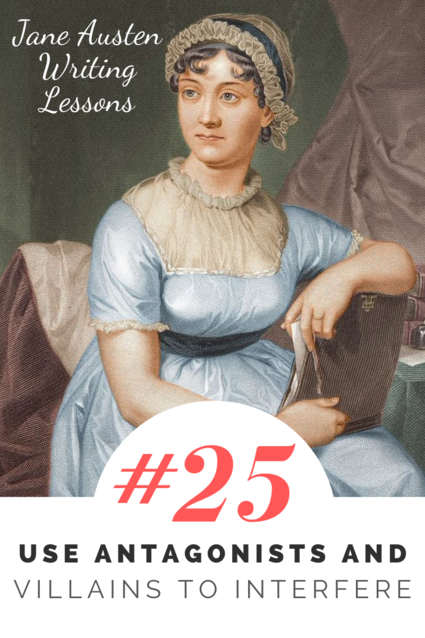










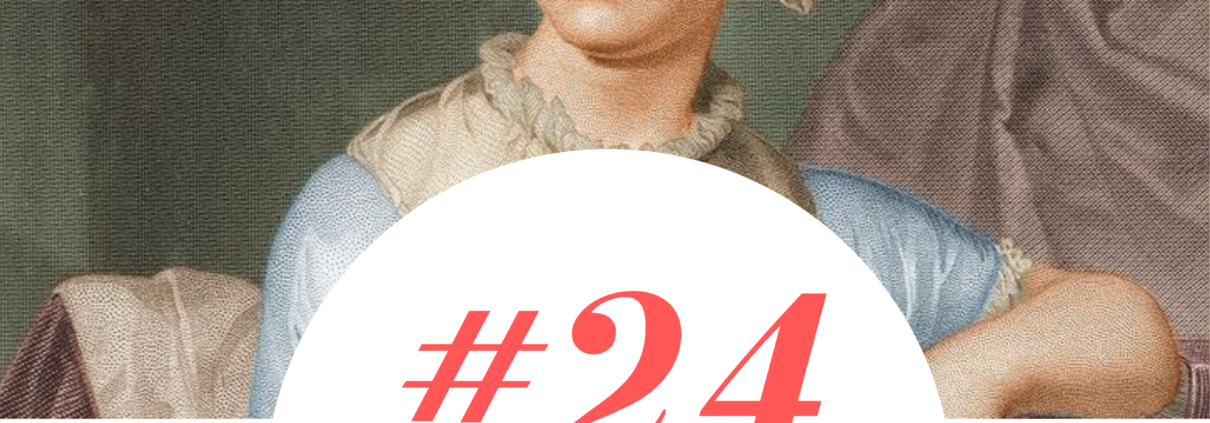
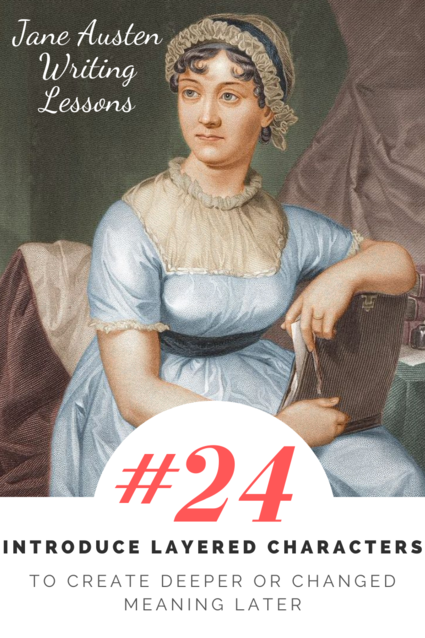
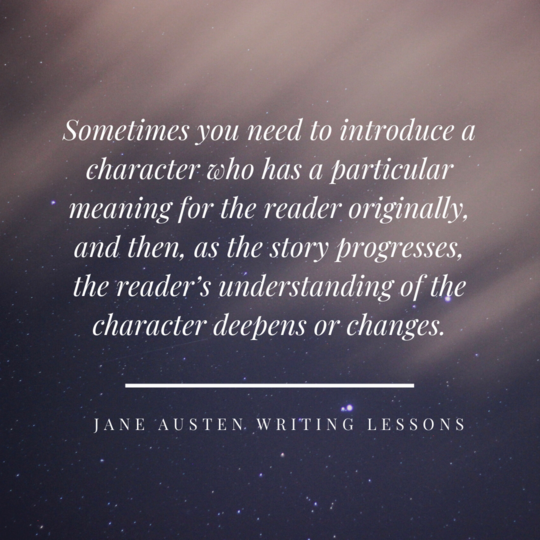
![According to Oxford Languages, positioning is “[arranging] in a particular place or way,” or a character portraying themselves “as a particular type of person.” (Jane Austen Writing Lessons)](https://www.katherinecowley.com/wp-content/uploads/2020/12/Layered-Characters-2-Small.png)

